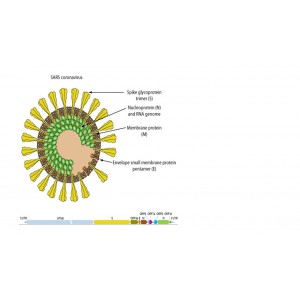Data sheet
| Background | 2019-nCoV/COVID/SARS-CoV2 makes use of a densely glycosylated, homotrimeric class I fusion spike (S) protein to gain entry into host cells. The S protein exists in a metastable prefusion conformation that undergoes a dramatic structural rearrangement to fuse the viral membrane with the host cell membrane. This process is triggered by binding of the S1 subunit to a host-cell receptor ACE2, which destabilizes the prefusion trimer, resulting in shedding of the S1 subunit and transition of the S2 subunit to a highly stable postfusion conformation. In order to engage a host-cell receptor, the receptor-binding domain (RBD) of S1 undergoes hinge-like conformational movements that transiently hide or expose the determinants of receptor binding. These two states are referred to as the “down” conformation and the “up” conformation, where “down” corresponds to the receptor-inaccessible state and “up” corresponds to the receptor-accessible state, which is thought to be less stable. Due to the indispensable function of the S protein it represents a vulnerable target for antibody-mediated neutralization, and characterization of the prefusion S structure would provide atomic-level information to guide vaccine design and development. |
| Expression host | HEK293 cells |
| Storage and Stability | 2 weeks, 2°C to 8 °C under sterile conditions after reconstitution. 3 months, -20°C under sterile conditions after reconstitution. 12 months, -70°C under sterile conditions after reconstitution. |
| Formulatin | Lyophilized from 0.22 μm filtered solution in 1x PBS, pH7.4. Contact us for customized product form or formulation. |
| Molecular Weight | The predicted molecular mass is 50 kDa, and the actual MW is about 50kDa in SDS-PAGE under reducing conditions. |
More info
The outbreak of a novel betacoronavirus (2019-nCov) represents a pandemic threat that has been declared a public health emergency of international concern. The CoV spike (S) glycoprotein is a key target for urgently needed vaccines, therapeutic antibodies, and diagnostics.
The novel coronavirus 2019-nCoV has recently emerged as a human pathogen in the city of Wuhan in China’s Hubei province, causing fever, severe respiratory illness and pneumonia. According to the World Health Organization on February 10th, 2020, there have been over 40,000 confirmed cases globally, leading to at least 900 deaths. The new pathogen was rapidly shown to be a novel member of the betacoronavirus genus that is closely related to several bat coronaviruses as well as severe acute respiratory syndrome coronavirus (SARS-CoV). Compared to SARS-CoV, 2019-nCoV appears to be more readily transmitted from human-to-human, spreading to multiple continents and leading to the WHO declaration of a Public Health Emergency of International Concern (PHEIC).
2019-nCoV makes use of a densely glycosylated, homotrimeric class I fusion spike (S) protein to gain entry into host cells. The S protein exists in a metastable prefusion conformation that undergoes a dramatic structural rearrangement to fuse the viral membrane with the host cell membrane. This process is triggered by binding of the S1 subunit to a host-cell receptor ACE2, which destabilizes the prefusion trimer, resulting in shedding of the S1 subunit and transition of the S2 subunit to a highly stable postfusion conformation. In order to engage a host-cell receptor, the receptor-binding domain (RBD) of S1 undergoes hinge-like conformational movements that transiently hide or expose the determinants of receptor binding. These two states are referred to as the “down” conformation and the “up” conformation, where “down” corresponds to the receptor-inaccessible state and “up” corresponds to the receptor-accessible state, which is thought to be less stable. Due to the indispensable function of the S protein it represents a vulnerable target for antibody-mediated neutralization, and characterization of the prefusion S structure would provide atomic-level information to guide vaccine design and development.
Related Products:
2019-nCOV/COVID-19 RNA detection kit


